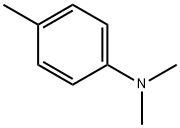| Identification | More | [Name]
N,N-DIMETHYL-P-TOLUIDINE | [CAS]
99-97-8 | [Synonyms]
4-DIMETHYLAMINOTOLUENE
4,N,N-TRIMETHYLANILINE
N,N,4-TRIMETHYLBENZENAMINE
N,N-DIMETHYL-4-METHYLANILINE
N,N-DIMETHYL-4-TOLUIDINE
N,N-DIMETHYL-PARA-TOLUIDINE
N,N-DIMETHYL-P-TOLUIDINE
Benzeneamine,N,N,4-trimethyl-
dimethyl-4-toluidine
Dimethyl-p-toluidine
Dimethyl-p-tolyl-amine
dimethyltoluidine
Dimetil-p-toluidina
N,N,4-Trimethylaniline
n,n,4-trimethyl-benzenamin
n,n-dimethyl-p-toluidin
N,N-Dimethyl-p-tolylamine
p-(dimethylamino)toluene
p,N,N-trimethylaniline
p-Methyl-N,N-dimethylaniline | [EINECS(EC#)]
202-805-4 | [Molecular Formula]
C9H13N | [MDL Number]
MFCD00008316 | [Molecular Weight]
135.21 | [MOL File]
99-97-8.mol |
| Chemical Properties | Back Directory | [Appearance]
light yellow liquid | [Melting point ]
-25°C | [Boiling point ]
211 °C(lit.)
| [density ]
0.937 g/mL at 25 °C(lit.)
| [vapor density ]
>1 (vs air)
| [vapor pressure ]
0.1 hPa (20 °C) | [refractive index ]
n20/D 1.546(lit.)
| [Fp ]
182 °F
| [storage temp. ]
Store below +30°C. | [solubility ]
0.65g/l | [form ]
Liquid | [pka]
pK1:7.24(+1) (25°C) | [color ]
Clear yellow | [Stability:]
Stable. Combustible. Incompatible with strong oxidizing agents. | [explosive limit]
7% | [Water Solubility ]
Miscible with alcohol, ether and chloroform. Immiscible with water. | [BRN ]
774409 | [Dielectric constant]
3.3(20℃) | [InChIKey]
GYVGXEWAOAAJEU-UHFFFAOYSA-N | [LogP]
1.729-2.81 at 35℃ | [CAS DataBase Reference]
99-97-8(CAS DataBase Reference) | [IARC]
2B (Vol. 115) 2018 | [EPA Substance Registry System]
N,N,4-Trimethylaniline (99-97-8) |
| Safety Data | Back Directory | [Hazard Codes ]
T | [Risk Statements ]
R23/24/25:Toxic by inhalation, in contact with skin and if swallowed .
R33:Danger of cumulative effects.
R52/53:Harmful to aquatic organisms, may cause long-term adverse effects in the aquatic environment . | [Safety Statements ]
S28:After contact with skin, wash immediately with plenty of ... (to be specified by the manufacturer) .
S36/37:Wear suitable protective clothing and gloves .
S45:In case of accident or if you feel unwell, seek medical advice immediately (show label where possible) .
S61:Avoid release to the environment. Refer to special instructions safety data sheet . | [RIDADR ]
1708 | [WGK Germany ]
3
| [RTECS ]
XU5803000
| [F ]
8-10-23 | [Autoignition Temperature]
425 °C | [TSCA ]
Yes | [HazardClass ]
6.1 | [PackingGroup ]
II | [HS Code ]
29214300 | [Hazardous Substances Data]
99-97-8(Hazardous Substances Data) | [Toxicity]
LD50 orally in Rabbit: 1650 mg/kg |
| Hazard Information | Back Directory | [General Description]
A clear colorless liquid with an aromatic odor. Density 0.937 g/cm3 (Lancaster) and insoluble in water. Hence floats on water. Toxic by skin absorption and inhalation. Flash point 181°F. May release toxic vapors when burned. | [Reactivity Profile]
N,N-DIMETHYL-P-TOLUIDINE(99-97-8) neutralizes acids in exothermic reactions to form salts plus water. May be incompatible with isocyanates, halogenated organics, peroxides, phenols (acidic), epoxides, anhydrides, and acid halides. May generate hydrogen, a flammable gas, in combination with strong reducing agents such as hydrides. | [Air & Water Reactions]
Tends to darken upon exposure to air. Insoluble in water. | [Health Hazard]
TOXIC; inhalation, ingestion or skin contact with material may cause severe injury or death. Contact with molten substance may cause severe burns to skin and eyes. Avoid any skin contact. Effects of contact or inhalation may be delayed. Fire may produce irritating, corrosive and/or toxic gases. Runoff from fire control or dilution water may be corrosive and/or toxic and cause pollution. | [Fire Hazard]
Combustible material: may burn but does not ignite readily. When heated, vapors may form explosive mixtures with air: indoors, outdoors and sewers explosion hazards. Contact with metals may evolve flammable hydrogen gas. Containers may explode when heated. Runoff may pollute waterways. Substance may be transported in a molten form. | [Chemical Properties]
light yellow liquid | [Uses]
N,N-Dimethyl-4-toluidine is an amine accelerator for the polymerization of e.g. dental methacrylic restorative materials | [Synthesis Reference(s)]
Synthetic Communications, 19, p. 3051, 1989 DOI: 10.1080/00397918908052700
Tetrahedron Letters, 8, p. 1849, 1967 | [Synthesis]
N,N-Dimethyl-p-toluidine was prepared by reacting p-toluidine with methanol and POCl3 in autoclave heated up to 280° C for 3h. | [Purification Methods]
Reflux for 3hours with 2 molar equivalents of Ac2O, then fractionally distil it under reduced pressure. Alternatively, dry it over BaO, distil and store it over KOH. The picrate has m 128o (from EtOH). Methods described for N,N-dimethylaniline are applicable here. [Beilstein 12 H 902, 12 III 2026, 12 IV 1874.] | [Toxics Screening Level]
The initial threshold screening level (ITSL) for n,n-dimethyl-p-toluidine (DMPT), is 28 μg/m3 based on an annual averaging time. |
|
|





